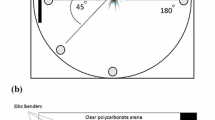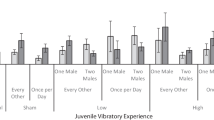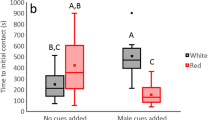Abstract
Multimodal courtship signals may compensate for environmental interference or loss of signals in some sensory modes but may also increase detection by eavesdroppers. Studies on the wolf spider Schizocosa ocreata (Hentz) have demonstrated that males eavesdrop on visual courtship cues of other males and subsequently initiate courtship. Since S. ocreata males use multimodal courtship signals, we examined responses of males to playback of signals in different sensory modes (visual, vibration, multimodal) to test their relative importance for eavesdropping on courting male rivals. We used a recently developed technique to present male wolf spiders with video and/or vibratory stimuli: (1) a multimodal courting male stimulus, with synchronous visual and vibratory cues; (2) a visual-only courting male stimulus (minus the vibratory cues); (3) vibratory cues only (minus the visual cues); and (4) a control (visual background, no courtship). In single-presentation (no-choice) tests, males displayed more courtship bouts and longer durations of courtship bouts to the vibratory stimulus compared with either the visual or multimodal stimuli. However, in two-choice tests where isolated vibratory cues were paired against visual or multimodal stimuli, test males responded with more courtship bouts and longer durations of courtship bouts to the multimodal and visual stimuli. Results of these experiments suggest that male wolf spiders may vary eavesdropping courtship behaviors to compensate for missing sensory information concerning the location and other distinguishing characteristics of the rival male and the whereabouts of the female.
Significance statement
Social eavesdropping is used to exploit information in signals of conspecifics, e.g., as a means of mate competition. Studies on Schizocosa ocreata wolf spiders have shown that males eavesdrop on visual courtship displays of other males and subsequently initiate multimodal courtship. We used video/vibration playback to examine responses of males to signals in different sensory modes (visual, vibration, both) and determine their relative importance for eavesdropping on courting male rivals. Results suggest that depending on sensory modes of their rivals’ signals, males may vary their own courtship displays to compensate for missing information. For example, when signals are presented individually, eavesdropping male response patterns are distinctly different from when presented a choice between modes. Males show more displays with isolated vibratory signals, but given a choice, males more often increase their tapping when multimodal cues were present. Ultimately, eavesdroppers that adjust behaviors in response to available sensory cues would be able to “level the playing field” with rivals and potentially increase the probability of gaining attention of females.





Similar content being viewed by others
Data availability
The datasets generated during and/or analyzed during the current study are available from the corresponding author on reasonable request.
References
Auld HL, Godin J-G (2015) Sexual voyeurs and copiers: social copying and the audience effect on male mate choice in the guppy. Behav Ecol Sociobiol 69:1795–1807
Balsby TJS, Dabelsteen T (2005) Simulated courtship interactions elicit neighbour intrusions in the whitethroat, Sylvia communis. Anim Behav 69:161–168. https://doi.org/10.1016/j.anbehav.2004.01.021
Bradbury JW, Vehrencamp SL (2011) Principles of animal communication, 2nd edn. Sinauer Associates, Sunderland (MA)
Candolin U (2003) The use of multiple cues in mate choice. Biol Rev 78:575–595. https://doi.org/10.1017/S1464793103006158
Clark DL, Uetz GW (1990) Video image recognition by jumping spiders (Araneae:Salticidae). Anim Behav 40:884–890. https://doi.org/10.1016/S0003-3472(05)80990-X
Clark DL, Uetz GW (1992) Morph-independent mate selection in a dimorphic jumping spider: demonstration of movement bias in female choice using video-controlled courtship behavior. Anim Behav 43:247–254. https://doi.org/10.1016/S0003-3472(05)80220-9
Clark DL, Uetz GW (1993) Signal efficacy and the evolution of male dimorphism in the jumping spider, Maevia inclemens (Araneae: Salticidae). Proc Natl Acad Sci 90:11954–11957. https://doi.org/10.1073/pnas.90.24.11954
Clark D, Roberts A, Uetz G (2012) Eavesdropping and signal matching in visual courtship displays of spiders. Biol Lett 8:375–378. https://doi.org/10.1098/rsbl.2011.1096
Clark DL, Kizer C, Sabovodny G, Hollenberg A, Roberts JA, Uetz GW (2015) The role of social experience in eavesdropping by male wolf spiders (Lycosidae). Anim Behav 106:89–97. https://doi.org/10.1016/j.anbehav.2015.05.001
Crockford C, Wittig R, Seyfarth RM, Cheney DL (2007) Baboons eavesdrop to deduce mating opportunities. Anim Behav 73:885–890. https://doi.org/10.1016/j.anbehav.2006.10.016
Delaney KJ, Roberts JA, Uetz GW (2007) Male signaling behavior and sexual selection in a wolf spider (Araneae: Lycosidae): a test for dual functions. Behav Ecol Sociobiol 62:67–75
Dougherty LR, Shuker DM (2015) The effect of experimental design on the measurement of mate choice: a meta-analysis. Behav Ecol 26:311–319. https://doi.org/10.1093/beheco/aru125
Doutrelant CL, McGregor PK (2000) Eavesdropping and mate choice in female fighting fish. Behaviour 137:1655–1669
Garcia MJ, Cronin A, Bowling T, Bushera H, Hunter KL, Taylor RC (2019) Dueling frogs: do male green tree frogs (Hyla cinerea) eavesdrop on and assess nearby calling competitors? Behav Ecol Sociobiol 73:21–31. https://doi.org/10.1007/s00265-018-2632-1
Gibson JS, Uetz GW (2008) Seismic communication and mate choice in wolf spiders: components of male seismic signals and mating success. Anim Behav 75:1253–1262. https://doi.org/10.1016/j.anbehav.2007.09.026
Gierszewski S, Keil M, Witte K (2018) Mate-choice copying in sailfin molly females: public information use from long-distance interactions. Behav Ecol Sociobiol 72:25. https://doi.org/10.1007/s00265-018-2441-6
Gordon SD, Uetz GW (2011) Multimodal communication of wolf spiders on different substrates: evidence for behavioral plasticity. Anim Behav 81:367–375. https://doi.org/10.1016/j.anbehav.2010.11.003
Gregg JD, Dudzinski KM, Smith HV (2007) Do dolphins eavesdrop on the echolocation signals of conspecifics? Int J Comp Psychol 20:65–88 https://escholarship.org/uc/item/20s5h7h9
Hauber M, Zuk M (2010) Social influences on communication signals: from honesty to exploitation. In: Szekely T, Moore AJ, Komdeur J (eds) Social behavior: genes, ecology and evolution. Cambridge University Press, Cambridge
Hebets EA, Papaj DR (2005) Complex signal function: developing a framework of testable hypotheses. Behav Ecol Sociobiol 57:197–214. https://doi.org/10.1007/s00265-004-0865-7
Hebets EA, Uetz GW (1999) Female responses to isolated signals from multimodal male courtship displays in the wolf spider genus Schizocosa (Araneae: Lycosidae). Anim Behav 57:867–872
Hebets EA, Uetz GW (2000) Leg ornamentation and the efficacy of courtship display in four species of wolf spider (Araneae: Lycosidae). Behav Ecol Sociobiol 47:280–286. https://doi.org/10.1007/s002650050667
Hebets EA, Vink C, Sullivan-Beckers L, Rosenthal MF (2013) The dominance of seismic signaling and selection for signal complexity in Schizocosa multimodal courtship displays. Behav Ecol Sociobiol 67:1483–1498. https://doi.org/10.1007/s00265-013-1519-4
Herb B, Biron S, Kidd MR (2003) Courtship by subordinate female Siamese fighting fish Betta splendens: their response to eavesdropping and naïve females. Behaviour 140:71–78
Kiflawi M, Gray DA (2000) Size-dependent response to conspecific mating calls by male crickets. Proc R Soc Lond B 267:2157–2161
Kozak EC, Uetz GW (2016) Cross-modal integration of multimodal courtship signals in a wolf spider. Anim Cogn 19:1173–1181. https://doi.org/10.1007/s10071-016-1025-y
Kozak EC, Uetz GW (2019) Male courtship signal modality and female mate preference in the wolf spider, Schizocosa ocreata – results of digital multimodal playback studies. Published on-line. Curr Zool. https://doi.org/10.1093/cz/zoz025
Loranger MJ, Bertram SM (2016) The effect of male dominance on female choice in a field cricket (Gryllus assimilis). Anim Behav 114:45–52
Matessi G, McGregor PK, Peake TM, Dabelsteen T (2005) Do male birds intercept and use rival courtship calls to adjust paternity protection behaviours? Behaviour 142:507–524
McClintock WJ, Uetz GW (1996) Female choice and pre-existing bias: visual cues during courtship in two Schizocosa wolf spiders (Araneae: Lycosidae). Anim Behav 52:167–181. https://doi.org/10.1006/anbe.1996.0162
McGregor PK (2005) Animal communication networks. Cambridge Univ. Press, Cambridge, p 657. https://doi.org/10.2980/1195-6860
Milner RNC, Jennions MD, Backwell PRY (2010) Eavesdropping in crabs: an agency for lady detection. Biol Lett 6:755–757. https://doi.org/10.1098/rsbl.2010.0384
Nelson ME, MacIver MA (2006) Sensory acquisition in active sensing systems. J Comp Physiol A 192:573–586. https://doi.org/10.1007/s00359-006-0099-4
Norton S, Uetz GW (2005) Mating frequency in Schizocosa ocreata (Hentz) wolf spiders: evidence for a mating system with female monogamy and male polygamy. J Arachnol 33:16–24
Ophir A, Galef BG (2003) Female Japanese quail that ‘eavesdrop’ on fighting males prefer losers to winners. Anim Behav 66:399–407. https://doi.org/10.1006/anbe.2003.2230
Page RA, Jones PL (2016) Overcoming sensory uncertainty: factors affecting foraging decisions in frog-eating bats. In: Bee M, Miller C (eds) Psychological mechanisms in animal communication. Animal signals and communication, vol 5. Springer, Cham
Partan SR (2017) Multimodal shifts in noise: switching channels to communicate through rapid environmental change. Anim Behav 124:325–337. https://doi.org/10.1016/j.anbehav.2016.08.003
Partan SR, Marler P (2005) Issues in the classification of multimodal communication signals. Am Nat 166:231–245. https://doi.org/10.1086/431246
Peake TM (2005) Eavesdropping in communication networks. In: McGregor PK (ed) Animal communication networks. Cambridge Univ. Press, Cambridge, pp 13–37
Peake TM, Terry AMR, McGregor PK, Dabelsteen T (2001) Male great tits eavesdrop on simulated male-to-male vocal interactions. Proc R Soc Lond B 268:1183–1187. https://doi.org/10.1098/rspb.2001.1648
Peckmezian T, Taylor PW (2015) A virtual reality paradigm for the study of visually mediated behaviour and cognition in spiders. Anim Behav 107:87–95. https://doi.org/10.1016/j.anbehav.2015.06.018
Persons MH, Uetz GW (2005) Sexual cannibalism and mate choice decisions in wolf spiders: influence of male size and secondary sexual characters. Anim Behav 69:83–94
Rhebergen F, Taylor RC, Ryan MJ, Page RA, Halfwerk W (2015) Multimodal cues improve prey localization under complex environmental conditions. Proc R Soc B 282:20151403. https://doi.org/10.1098/rspb.2015.1403
Roberts JA, Uetz GW (2008) Discrimination of variation in a male signaling trait affects optomotor response in visual predators. Ethology 114:557–563. https://doi.org/10.1111/j.1439-0310.2008.01491.x
Roberts JA, Galbraith E, Milliser J, Taylor PW, Uetz GW (2006) Absence of social facilitation of courtship in the wolf spider, Schizocosa ocreata (Hentz) (Araneae: Lycosidae). Acta Ethologica 9:71–77. https://doi.org/10.1007/s10211-006-0018-2
Roberts JA, Taylor PW, Uetz GW (2007) Consequences of complex courtship display: predator detection of multi-modal signaling. Behav Ecol 18:236–240. https://doi.org/10.1093/beheco/arl079
Rosenthal GG (2007) Spatiotemporal dimensions of visual signals in animal communication. Annu Rev Ecol Evol Syst 38:155–178. https://doi.org/10.1146/annurev.ecolsys.38.091206.095745
Scheffer SJ, Uetz GW, Stratton GE (1996) Sexual selection, male morphology, and the efficacy of courtship signaling in two wolf spiders. (Araneae: Lycosidae). Behav Ecol Sociobiol 38:17–24. https://doi.org/10.1007/s002650050212
Searcy WA, Nowicki S (2005) The evolution of animal communication: reliability and deception in signaling systems. Princeton Univ. Press, Princeton 270 pp
Smith CL, Taylor A, Evans CS (2011) Tactical multimodal signaling in birds: facultative variation in signal modality reveals sensitivity to social costs. Anim Behav 82:521–527. https://doi.org/10.1016/j.anbehav.2011.06.002
Stoffer B, Uetz GW (2015) The effects of social experience with varying male availability on female preference in a wolf spider. Behav Ecol Sociobiol 69:927–937. https://doi.org/10.1007/s00265-015-1904-2
Stoffer B, Uetz GW (2016a) Social experience affects female mate preferences for a visual trait in a wolf spider. Behav Ecol 27:252–261. https://doi.org/10.1093/beheco/arv143
Stoffer B, Uetz GW (2016b) Tuft size matters: the effects of adult visual social experience on female mate preferences in a wolf spider. Behav Ecol Sociobiol 70:2211–2221. https://doi.org/10.1007/s00265-016-2225-9
Stoffer B, Uetz GW (2017) The effects of experience with different courtship modalities on unimodal and multimodal preferences in a wolf spider. Anim Behav 123:187–196. https://doi.org/10.1007/s00265-015-1904-2
Stoffer B, Williams M, Uetz GW (2016) Variation in female mate preference in response to eavesdropping “interloper” males. Behav Ecol 27:1609–1616. https://doi.org/10.1093/beheco/arw083
Uetz GW, Clark DL (2014) A tale of two spiders: investigating communication in two unique model species using video digitization and playback. In: Yasukawa K (ed) Animal behavior: how and why animals do the things they do, Integration and application with case studies, vol 3. Praeger-PSI, pp 63–99
Uetz GW, Norton S (2007) Preference for male traits in female wolf spiders varies with the choice of available males, female age and reproductive state. Behav Ecol Sociobiol 61:631–641. https://doi.org/10.1007/s00265-006-0293-y
Uetz GW, Roberts JA (2002) Multi-sensory cues and multi-modal communication in spiders: insights from video/audio playback studies. Brain Behav Evol 59:222–230. https://doi.org/10.1159/000064909
Uetz GW, Papke R, Kilinc B (2002) Influence of feeding regime on body size, body condition and a male secondary sexual character in schizocosa ocreata wolf spiders (Araneae, Lycosidae): Condition-dependence in a visual signaling trait. J Arachnol 30(3):461–469
Uetz GW, Roberts JA, Taylor PW (2009) Multimodal communication and mate choice in wolf spiders: female responses to multimodal vs. unimodal male signals in two sibling wolf spider species. Anim Behav 78:299–305. https://doi.org/10.1016/j.anbehav.2009.04.023
Uetz GW, Clark DL, Roberts JA, Rector M (2011) Effect of visual background complexity and light level on the detection of visual signals of male Schizocosa ocreata wolf spiders by female conspecifics. Behav Ecol Sociobiol 65(4):753–761
Uetz GW, Clark DL, Roberts JA, Gibson JS, Gordon SD (2013) Active space of multimodal signals of wolf spiders in a complex litter environment. Behav Ecol Sociobiol 67:1471–1482. https://doi.org/10.1007/s00265-013-1557-y
Uetz GW, Clark DL, Roberts JA (2016) Multimodal communication in wolf spiders (Lycosidae) – an emerging model for study. In: Naguib M, Mitani JC, Simmons LW, Barrett L, Healy S, Zuk M (eds) Advances in the Study of Behavior, vol 48, pp 117–159
Uetz GW, Stoffer B, Lallo M, Clark DL (2017) Complex signals and comparative mate assessment in wolf spiders: results from multimodal playback studies. Anim Behav 134:283–299. (Special Issue: Communicative Complexity). https://doi.org/10.1016/j.anbehav.2017.02.007
Webster MM, Laland KN (2013) Local enhancement via eavesdropping on courtship displays in male guppies, Poecilia reticulate. Anim Behav 86:75–83. https://doi.org/10.1016/j.anbehav.2013.04.014
Acknowledgments
This research was supported by the National Science Foundation grants IOS-1026995 (G.W.U.) and IOS-1026817 (D.L.C.), and an NSF Research Experiences for Undergraduates Site Grant DBI 1262863 (G.W.U.). We thank the Cincinnati Nature Center for permitting us to collect spiders on their property. Additional thanks to R Gilbert, A Sweger, A Kluckman, R Wilson, M Williams, C Vaughn, and M. Lallo for various assistance on this project.
Author information
Authors and Affiliations
Corresponding author
Ethics declarations
Ethical approval
All applicable international, national, and/or institutional guidelines for the care and use of animals were followed. This article does not contain any studies with human participants performed by any of the authors.
Additional information
Communicated by J. Pruitt
Publisher’s note
Springer Nature remains neutral with regard to jurisdictional claims in published maps and institutional affiliations.
Rights and permissions
About this article
Cite this article
Uetz, G.W., Clark, D.L., Kane, H. et al. Listening in: the importance of vibratory courtship signals for male eavesdropping in the wolf spider, Schizocosa ocreata. Behav Ecol Sociobiol 73, 133 (2019). https://doi.org/10.1007/s00265-019-2743-3
Received:
Revised:
Accepted:
Published:
DOI: https://doi.org/10.1007/s00265-019-2743-3




